If you want to know about the climate specific design principles or passive cooling or sustainable site planning, please click the link.
Passive Design refers to the use of natural elements such as sunlight, wind, and shade to create comfortable living spaces while minimizing energy consumption. It is an architectural approach that relies on building orientation, site selection, building materials, insulation, and ventilation systems to reduce the need for mechanical heating, cooling, and lighting.
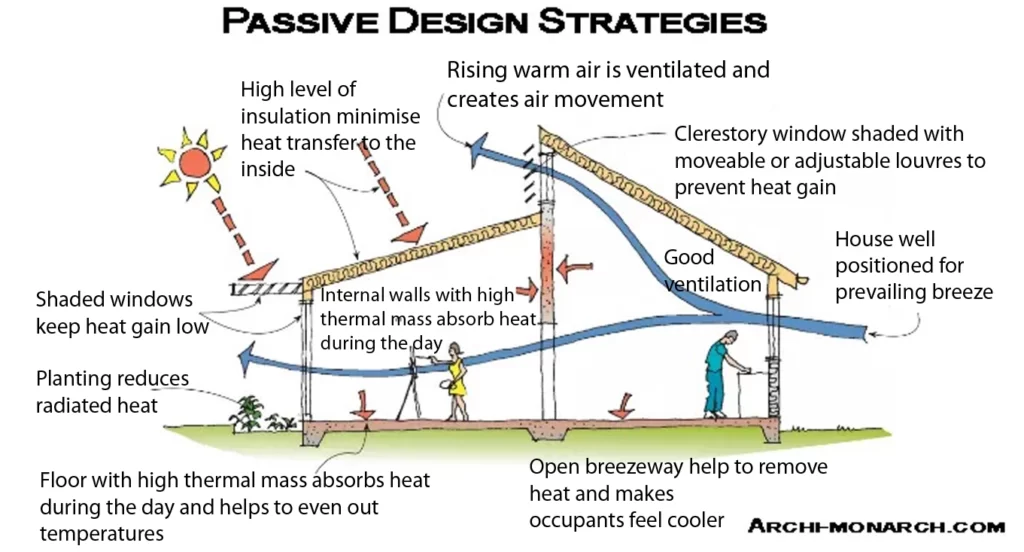
Passive Design is not a specific set of design rules but rather a collection of principles that guide architects, engineers, and builders in creating energy-efficient and comfortable buildings. These principles are based on the use of passive solar design, natural ventilation, and thermal mass to create spaces that are warm in winter, cool in summer, and comfortable year-round.
‘Passive design’ is design that takes advantage of the climate to maintain a comfortable temperature range in the home.
Importance of Passive Design
Passive Design is crucial in the fight against climate change and energy consumption. Buildings are responsible for approximately 40% of global carbon emissions, and improving their energy efficiency is essential to reducing greenhouse gas emissions.

Passive Design can reduce energy consumption by up to 90% compared to traditional buildings, which means significant savings in energy bills and a more sustainable built environment.
Passive Design also promotes occupant comfort and health by creating spaces that are well-ventilated, well-lit, and thermally comfortable. This can improve productivity, reduce sick days, and enhance the overall quality of life.
Overview of Passive Design Principles
Passive Design principles are based on the use of natural elements such as sunlight, wind, and shade to create comfortable living spaces. These principles include:
- Site and Orientation: Choosing the right site and orienting the building to maximize solar gain and minimize heat loss.
- Building Envelope: Insulating and sealing the building envelope to reduce heat loss and air leakage. Using high-performance windows and shading devices to regulate heat gain and glare.
- Ventilation: Providing natural or mechanical ventilation to maintain indoor air quality and thermal comfort.
- Heating and Cooling: Using passive solar design, geothermal heating, or radiant cooling to regulate indoor temperatures.
- Lighting: Using daylighting strategies and efficient light fixtures to reduce the need for artificial lighting and minimize light pollution.
- Water Efficiency: Using water-efficient fixtures, rainwater harvesting, and graywater reuse to reduce water consumption.
By following these principles, architects, engineers, and builders can create buildings that are energy-efficient, comfortable, and sustainable.
Good passive design should reduce or eliminate the need for additional heating or cooling depending on your location and often relies on an active occupant to work properly. A passively designed home can deliver a lifetime of thermal comfort, low energy bills, and low greenhouse gas emissions.
With passive design, building features such as orientation, thermal mass, insulation and glazing work together to take advantage of natural sources of heating and cooling, such as sun and breezes, and to minimise unwanted heat gain and loss.
It is best to use passive design principles when designing or building a new home, but many features of passive design can be added through renovations or simple home improvements.
1) Site and Orientation
i) Choosing the Right Site
Choosing the right site is crucial for Passive Design. A well-chosen site can help maximize the benefits of natural elements such as sunlight and wind while minimizing their drawbacks.
When selecting a site, consider factors such as the slope, vegetation, soil quality, and microclimate. A south-facing slope with minimal vegetation and good drainage is ideal for solar gain, while a site with trees or hills to the west can provide natural shading in the afternoon.
ii) Understanding Solar Orientation
Understanding solar orientation is essential for Passive Design. The sun’s position in the sky changes throughout the day and throughout the year, and proper orientation can maximize solar gain and minimize heat loss.
In the Northern Hemisphere, south-facing windows and walls receive the most solar gain, while north-facing walls receive the least. East-facing windows can provide morning sun, while west-facing windows can provide afternoon sun but can also cause overheating in summer.
Passive solar design techniques such as overhangs, louvers, and shading devices can help regulate solar gain and glare.
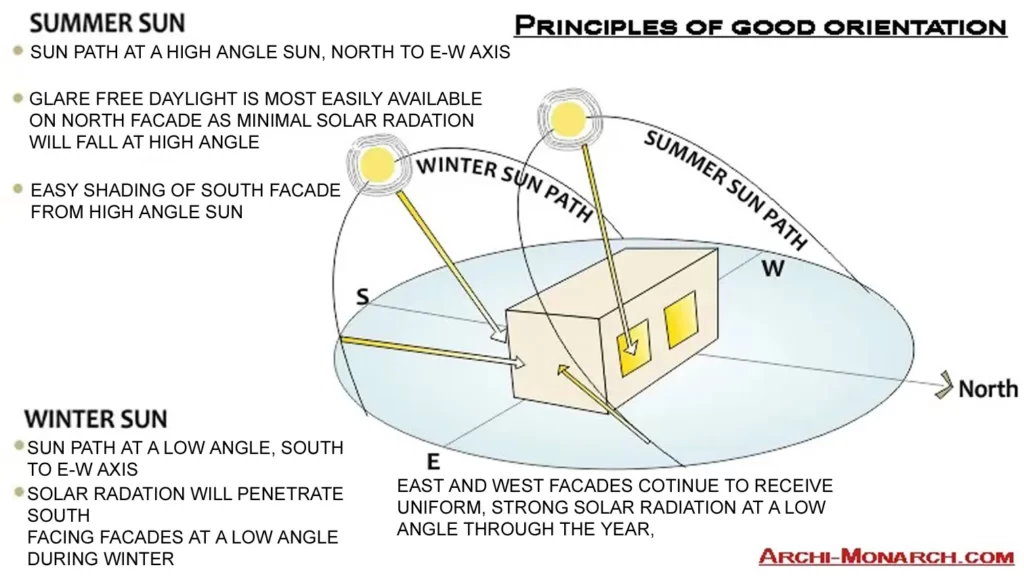
Orientation is the way you place your home on its site to take advantage of the sun and the prevailing winds in your location. Good orientation can significantly improve comfort and reduce your heating and cooling needs.
iii) Importance of Wind Patterns
Wind patterns also play a crucial role in Passive Design. Natural ventilation can help regulate indoor air quality and temperature, but it requires a good understanding of wind patterns and their effects on building design.
Buildings should be oriented to take advantage of prevailing winds, and openings such as windows and vents should be strategically placed to promote cross-ventilation. Landscaping and site features such as trees and hills can also affect wind patterns and should be considered when designing for natural ventilation.
Additionally, wind turbines can be incorporated into the design to provide renewable energy and further reduce reliance on fossil fuels.
2) Building Envelope
i) Insulation and Air-Sealing
Insulation and air-sealing are critical components of Passive Design. The building envelope must be well-insulated and sealed to minimize heat loss and air leakage.
High-quality insulation can significantly reduce the need for mechanical heating and cooling, resulting in energy savings and improved thermal comfort.
Air-sealing prevents air leaks that can reduce indoor air quality and compromise the effectiveness of insulation. Proper insulation and air-sealing can also reduce noise pollution and improve fire resistance.
Insulation acts as a barrier to heat flow and is essential for keeping your home warm in winter and cool in summer. Some types of insulation can also help with weatherproofing and soundproofing.
Insulation
- Insulation is particularly important for buildings in colder climates. “Insulation helps the building envelope to resist the conductive flow of heat, and it is typically most effective when installed as continuous insulation.
- Insulation acts as a barrier to heat flow and is essential for keeping your home warm in winter and cool in summer.
- It can also help with weatherproofing and soundproofing.
- A well-insulated and well-designed home provides year-round comfort, cutting cooling and heating bills by up to half and reducing greenhouse gas emissions.
- Climatic conditions determine the appropriate level of insulation as well as the most appropriate type to choose — bulk, reflective or composite.
- The most economical time to install insulation is during construction.
Sealing your home
- Air leakage accounts for 15–25% of winter heat loss in buildings and can contribute to significant loss of ‘coolth’ in climates where air conditioners are used.
- Sealing your home against air leaks is one of the simplest upgrades you can undertake to increase your comfort while reducing energy bills and greenhouse gas emissions.
- The more extreme your climate, the more beneficial sealing is, with the exception of naturally ventilated homes in the tropics.
- As sealing your home and increasing insulation levels can also create condensation and indoor air quality problems, this article explains how condensation works, which climates present the greatest condensation risk and how you can limit its impact.
ii) Windows and Glazing
Windows and glazing are essential elements of Passive Design. They can provide natural light, solar heat gain, and views to the outdoors, but they can also be significant sources of heat loss and gain.
High-performance windows and glazing can reduce energy consumption by preventing heat transfer and blocking UV radiation. Double or triple-glazed windows, low-e coatings, and gas fills can significantly improve energy efficiency while maintaining visual transparency.
Proper window placement and sizing can also enhance natural ventilation and solar shading.
Glazed windows and doors have a significant effect on your home’s thermal performance – up to 40% of a home’s heating energy can be lost and up to 87% gained through glazing. Choose the right glazing for your climate and orientation.
Glazing
- Glazed windows and doors bring in light and fresh air and offer views that connect interior living spaces with the outdoors.
- However, they can be a major source of unwanted heat gain in summer and heat loss in winter. Up to 40% of a home’s heating energy can be lost and up to 87% of its heat gained through glazing.
- These thermal performance problems can be largely overcome by selecting the right glazing systems for your orientation and climate, and considering the size and location of window openings in your design.
iii) Shading Devices
Shading devices are critical to Passive Design. They can help control solar gain and glare while maintaining visual transparency and access to views. The ideal shading device depends on the building’s orientation, climate, and function.
For example, horizontal shading devices such as overhangs and awnings are effective for south-facing windows in hot climates, while vertical shading devices such as louvers and fins are suitable for east and west-facing windows in temperate climates.
Shading devices can also be designed to incorporate passive cooling strategies such as evaporative cooling and night purging.
Appropriate shading — which can include eaves, awnings, shutters, and plantings — can maximise thermal comfort by allowing in winter sun but blocking summer rays. The most appropriate strategy will differ with climate and orientation.
Shading
- Shading of your house and outdoor spaces reduces summer temperatures, improves comfort and saves energy.
- Direct sun can generate the same heat as a single bar radiator over each square metre of a surface.
- Effective shading — which can include eaves, window awnings, shutters, pergolas and plantings — can block up to 90% of this heat.
- Shading of glass to reduce unwanted heat gain is critical, as unprotected glass is often the greatest source of heat gain in a house.
- However, poorly designed fixed shading can block winter sun.
- By calculating sun angles for your location, and considering climate and house orientation, you can use shading to maximise thermal comfort.
3) Ventilation
i) Natural Ventilation
Natural ventilation is an essential strategy in Passive Design. It can improve indoor air quality, regulate temperature and humidity, and reduce the need for mechanical ventilation. Natural ventilation relies on the natural flow of air through the building, driven by wind pressure and buoyancy.

The design must include openings such as windows, vents, and skylights to allow for adequate airflow. The placement and size of these openings should be carefully considered to promote cross-ventilation and avoid areas of stagnation. Additionally, natural ventilation can be enhanced with the use of stack effect, thermal chimneys, and windcatchers.
Ventilation with fresh air is essential for a healthy home, but it should be controlled rather than through unwanted air leaks. Sealing your home is one of the simplest upgrades you can make to increase your comfort and reduce energy costs.
ii) Mechanical Ventilation:
Mechanical ventilation is an alternative to natural ventilation and can be used in Passive Design. It involves the use of fans, ducts, and other mechanical systems to circulate air throughout the building. Mechanical ventilation can provide better control over indoor air quality and temperature but requires energy to operate.
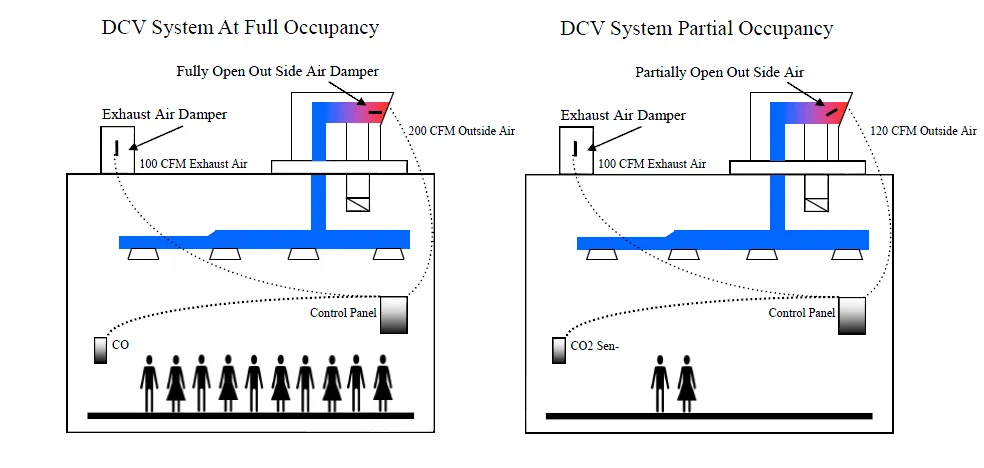
The design must consider the appropriate system size, location, and noise level. Energy-efficient mechanical ventilation systems such as energy recovery ventilators (ERVs) and heat recovery ventilators (HRVs) can also be used to reduce energy consumption.
iii) Heat Recovery Ventilation:
Heat recovery ventilation (HRV) is an energy-efficient mechanical ventilation system that can be used in Passive Design. HRVs can recover up to 90% of the heat from outgoing stale air and transfer it to incoming fresh air, reducing the energy needed for heating and cooling.
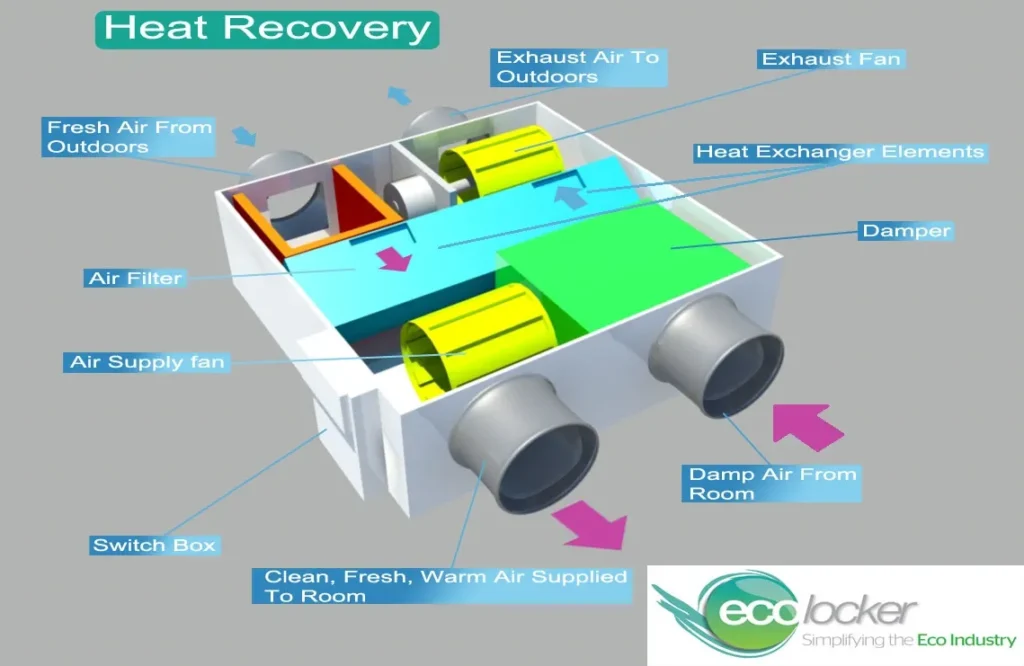
HRVs are especially useful in colder climates where natural ventilation is limited. The design must consider the appropriate size and location of the HRV system and the optimal balance between air exchange and energy recovery.
Additionally, HRVs can be combined with other passive design strategies such as natural ventilation and thermal mass for improved energy efficiency.
4) Heating and Cooling
i) Passive Solar Heating and Cooling
Passive solar heating is an important strategy in Passive Design. It involves the use of the sun’s energy to heat the building naturally, reducing the need for mechanical heating.
The design must consider the orientation and placement of the building to maximize solar exposure and the use of materials with high thermal mass to store and distribute the heat.

Passive solar heating can be achieved through strategies such as direct gain, indirect gain, and isolated gain. Direct gain involves the use of south-facing windows to allow sunlight to enter the building and heat thermal mass materials. Indirect gain involves the use of a separate space, such as a sunroom or greenhouse, to collect and distribute solar heat. Isolated gain involves the use of a separate thermal mass structure, such as a Trombe wall, to collect and distribute solar heat.
Passive cooling techniques cool both the house and the people in it, using elements such as air movement, evaporative cooling and thermal mass.

Passive solar heating
Passive solar heating is the least expensive way to heat your home.
- Put simply, design for passive solar heating keeps out summer sun and lets in winter sun while ensuring that the building envelope keeps that heat inside in winter and allows any built up heat to escape in summer.
- Orientation, thermal mass, sealing and other elements all contribute to the design of a house that benefits from passive solar heating.
Passive cooling
Passive cooling is the least expensive way to cool your home.
- To be effective, passive cooling techniques need to cool both the house and the people in it — with elements such as air movement, evaporative cooling and thermal mass.
- Passive cooling design techniques can be applied to new homes as well as renovations, across a range of different climate zones.

Thermal mass
- Thermal mass is the ability of a material to absorb and store heat energy.
- A lot of heat energy is needed to change the temperature of high-density materials such as concrete, bricks and tiles: these materials have high heat storage capacity and are therefore said to have high thermal mass.
- Lightweight materials such as timber have low thermal mass.
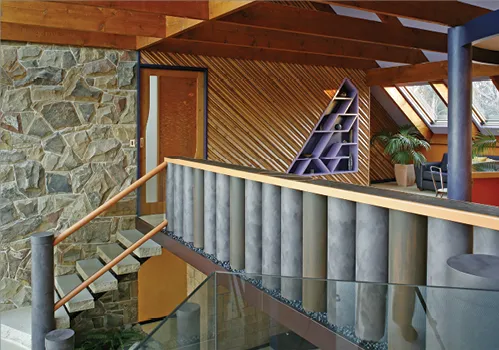
Use of materials with high thermal mass throughout your home can save significantly on heating and cooling bills, but thermal mass must be used appropriately.
ii) Geothermal Heating and Cooling
Geothermal heating and cooling is an energy-efficient strategy in Passive Design. It involves the use of the earth’s thermal energy to heat and cool the building.
Geothermal systems use a heat pump to extract heat from the ground during the winter and transfer it to the building, and during the summer, it removes heat from the building and transfers it to the ground.
The design must consider the appropriate size and location of the geothermal system and the availability of suitable geological conditions. Geothermal systems can significantly reduce energy consumption and carbon emissions.
iii) Radiant Cooling
Radiant cooling is an effective strategy in Passive Design, especially in hot climates. It involves the use of a radiant cooling system to remove heat from the building through the floor or ceiling.
Radiant cooling systems use water or other fluids to circulate through pipes embedded in the building structure. The design must consider the appropriate size and location of the radiant cooling system and the optimal balance between cooling capacity and energy consumption.
Radiant cooling can provide improved thermal comfort and energy efficiency, especially when combined with other passive design strategies such as natural ventilation and shading.
5) Lighting
i) Daylighting Strategies
Daylighting is a critical strategy in Passive Design that involves the use of natural light to illuminate indoor spaces. It can improve occupant health and productivity, reduce energy consumption, and enhance the aesthetic quality of the building.
Daylighting strategies involve the placement and size of windows, skylights, and light wells, and the use of reflective surfaces and shading devices to control the amount and direction of natural light. The design must consider the appropriate size and orientation of the openings and the potential for glare and overheating.
Skylights
Skylights can make a major contribution to energy efficiency and comfort.
- They are an excellent source of natural light, perhaps admitting more than three times as much light as a vertical window of the same size, and can improve natural ventilation. However, they can be a major source of unwanted heat gain in summer and heat loss in winter.
- Factors to be considered when selecting from the many skylight options available include sizing and spacing (to control glare and heat gain), energy efficiency and appropriateness for climate.
ii) Light Fixtures and Controls
Light fixtures and controls are essential components of Passive Design. The selection of light fixtures must consider the appropriate color temperature, color rendering, and efficiency. The use of LED and other energy-efficient light sources can significantly reduce energy consumption.
The design must also consider the use of lighting controls such as occupancy sensors, daylight sensors, and dimmers, to optimize lighting levels and reduce energy waste. Lighting controls can also improve occupant comfort and reduce light pollution.
iii) Light Pollution Reduction
Light pollution reduction is an important consideration in Passive Design. Light pollution is the excessive use of artificial light that can affect human health, wildlife, and the environment. Passive Design strategies can help reduce light pollution by minimizing the use of artificial light, controlling the direction and intensity of light, and using shielded light fixtures.
The design must consider the appropriate placement and direction of light fixtures to minimize light trespass and glare. Additionally, the use of natural light sources can reduce the need for artificial light and enhance the aesthetic quality of the building.
6) Water Efficiency
i) Water Conservation Strategies
Water conservation is a critical aspect of Passive Design. The design must consider strategies to reduce water consumption and minimize wastewater generation.
Water conservation strategies may include the use of low-flow fixtures, efficient appliances, and water-efficient landscaping. The design must also consider the use of alternative water sources, such as rainwater harvesting and graywater reuse.
ii) Rainwater Harvesting:
Rainwater harvesting is an effective strategy in Passive Design that involves the collection and storage of rainwater for future use. The design must consider the appropriate size and location of the rainwater harvesting system and the potential for water quality issues.
Rainwater harvesting systems may include rooftop catchment, storage tanks, and filtration systems. The harvested rainwater can be used for non-potable purposes such as irrigation, toilet flushing, and laundry.
iii) Graywater Reuse:
Graywater reuse is another water conservation strategy in Passive Design that involves the treatment and reuse of non-potable wastewater for other purposes. The design must consider the appropriate treatment and distribution systems and the potential for health and safety issues.
Graywater can be treated and reused for purposes such as irrigation, toilet flushing, and laundry. The use of graywater can significantly reduce water consumption and wastewater generation and improve the sustainability of the building.
7) Conclusion
Passive Design offers numerous benefits to building occupants, the environment, and society as a whole. Some of these benefits include improved indoor air quality, enhanced occupant comfort and productivity, reduced energy consumption and carbon emissions, and increased resilience to climate change.
Passive Design can also help reduce water consumption and wastewater generation, minimize waste, and improve the health and well-being of building occupants. Passive Design is an effective strategy for creating sustainable, healthy, and resilient buildings.
Future of Passive Design
The future of Passive Design is promising, as the demand for sustainable and energy-efficient buildings continues to grow. Advances in technology, materials, and design strategies are making Passive Design more accessible and affordable than ever before.
The integration of renewable energy sources such as solar and geothermal can further improve the energy efficiency and sustainability of Passive Design buildings. The future of Passive Design is also closely tied to the future of sustainable and resilient communities, as the design can help create healthy and sustainable neighborhoods and cities.
Passive Design offers a powerful strategy for creating sustainable, healthy, and resilient buildings. As such, architects, engineers, builders, and policymakers have a crucial role to play in promoting and implementing Passive Design strategies. To take action, stakeholders can:
- Educate themselves and others about the benefits and principles of Passive Design.
- Incorporate Passive Design strategies into building design and construction projects.
- Advocate for Passive Design and sustainable building policies and incentives.
- Partner with community organizations, governments, and other stakeholders to promote sustainable building practices and Passive Design.
- Encourage and support research and development of new technologies, materials, and design strategies to advance Passive Design.
By taking these actions, stakeholders can contribute to a more sustainable, resilient, and healthy built environment for current and future generations.